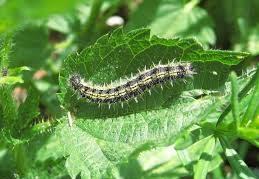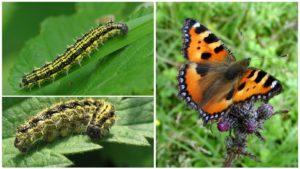What does the urticaria caterpillar and its beautiful butterfly eat?
With the onset of the first warm days, many different insects wake up. They also include butterflies that flutter among the flowers and trees, creating a special atmosphere. Some species of these beautiful creatures are malicious pests, but among them there are also many useful butterflies, one of which is Urticaria.
Content
What does urticaria look like (photo)
Name: Hives
Latin:Aglais urticaeClass: Insects - Insecta
Squad: Lepidoptera - Lepidoptera
Family: Nymphalidae - Nymphalidae
 | Habitats: | parks, forests, edges, highlands |
 | Features: | beautiful diurnal butterfly, distinguishes several colors |
 | Benefit or harm: | lives on nettles, hops or hemp, not considered a pest |
Description of the insect

Urticaria caterpillar.
Butterfly Urticaria is small in size. Its wingspan reaches 4,5-5 cm. The main color of the wings is bright orange with small black spots of various shapes.
The hind wings of the insect, closer to the back, have a dark brown color, which is separated by a clear line from the main orange color. The edges of the front and rear wings of the butterfly have notches and one pronounced protrusion each. There is also a black line along the edge of the wings, with spots of bright blue.
The pattern of spots on the forewings is unique for each individual insect.
Insect development cycle
The development cycle of the Urticaria butterfly includes several stages:
barrel-shaped and yellow in color. One butterfly lays on average 100-200 eggs at a time and places them on the underside of nettle leaves;
Urticaria larvae are almost black in color with two bright yellow stripes on the sides. The body of the caterpillar is densely covered with short bristles and outgrowths resembling spikes in shape. The body length of the caterpillar is 1-2 cm. Most of the time, the larvae live in groups and only before pupation go into "free swimming";
have an angular shape with small spike-like growths. The length of the pupa reaches 2-2,5 cm. The color is dark brown, with small golden dots. They are located upside down tightly attached to the walls of buildings, fences or plant stems.
Urticaria butterfly habitat
Butterflies of this species are found in many countries of Europe and Asia. Urticaria is also widespread in Russia. It can be found even in Yakutia, the Magadan region and on the territory of Kamchatka.
The only region of Russia where urticaria does not live is the Far North.
The habitat of butterflies is quiet, calm places in squares, gardens, fields. In winter, butterflies seek shelter in crevices in tree bark, basements, and on balconies.
Character and lifestyle
The moth is not a pest, it feeds on plants without causing much harm to them. The main and main food is nettle, which gave the name to the insect.
Caterpillars prefer:
- dandelion;
- primrose;
- marjoram.
Butterflies eat:
- hops;
- hemp;
- nettle
Clever butterflies are still those gourmets. They can feast on fermented birch sap.
Urticaria is the first butterfly that wakes up in early spring. She flies from the first rays to the sunset. They store food for the winter. Depending on the conditions during the season, the number of offspring may vary. In drought conditions, the number is much less.
Moths are long-lived among the representatives of the species. Their lifespan reaches 9 months. In the spring, mating games begin, the female lays her eggs on nettle leaves. 2 generations are born per season.
The benefits and harms of the appearance of urticaria on the site
Adults do absolutely no harm and are rather beneficial insects. Urticaria plays a very important role in the pollination of many plants. They are even put in second place after bees among pollinating insects.
As for the larvae of the butterfly, in most cases they feed on the leaves of various types of nettle and can rarely be seen on crops planted by humans.
Do I need to fight hives
Butterfly Urticaria cannot be considered a harmful insect, as it benefits many plant species. For this reason, it is not worth fighting them.
In addition, Urticaria has plenty of natural enemies.
Butterflies are threatened by:
- mammals;
- reptiles;
- birds;
- rodents.
Conclusion
Butterfly Urticaria is a harmless representative of the fauna and is even among the beneficial pollinating insects. Therefore, having noticed this motley beauty on the territory of the site, you should not be afraid or go in search and destruction of its larvae and oviposition.
Previous